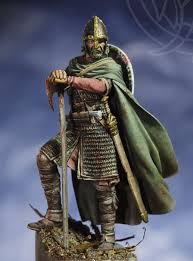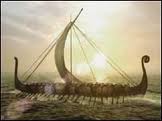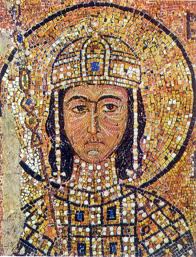In a previous article I discussed the fate of the English Varangian Guard at the Battle of Dyrrhachium in October 1081. I mentioned that most of the evidence we have suggests that the first (though unlikely only) major wave of English exiles fleeing Norman repression left England in about 1072, possibly after the suppression of the resistance of Hereward the Wake in Ely. They most probably arrived in Constantinople in 1074. Do we know anything more about the roots of this sad exile? Who was involved? How many English left?

Játvarðar Saga
There are two principal sources regarding what happened, neither very accessible, one being in Latin and the other in Icelandic. The first and most important is a section of the early 13th-century French chronicle known as the Chronicon universale anonymi Laudunensis (‘the universal chronicle of Laon’). I’ll call this the ‘Latin text’. The second is a 14th century Icelandic text, the Játvarðar Saga, a short saga devoted to the life of Edward the Confessor. I’ll call this the ‘Icelandic Saga’ or the ‘Saga of King Edward the Confessor’. There are great similarities between the two texts. It’s likely that they both drew on similar source material.
I’ll start with the Latin text. French scholar Krijnie Ciggaar provided a résumé of the story of the English exiles. I’ve translated this into English:
While in 1066 William the Conqueror had conquered England, a certain number of nobles went into exile. First, they went in the direction of Spain, ravaged the town of Septa (in North Africa, just opposite Gibraltar), then the Balearic islands and landed finally in Sardinia. There they learnt that Constantinople was being besieged by the pagans. With the help of the chiefs of Sardinia they went to Constantinople, where they forced the pagans to lift the siege. The Byzantine emperor received them with much honour and gifts. They even obtained a place of residence within the Imperial town. However some among them were not content with this state of things. To give free reign to their activities, the Byzantine emperor suggested to them to go to the north where there was to be found a region that had once belonged to the Byzantine empire, but which, at this time, was in the hands of the pagans. Following the advice of the emperor, they set out to conquer this region, and they succeeded. The English gave to the towns of this region and to those that they themselves founded, the names of towns in England. But they kept their spirit of independence, because their clergy were consecrated in Hungary so as not to be dependent on the patriarch of Constantinople. An envoy of the Byzantine emperor was killed because he had demanded taxes. One Englishman, called Hardigt, made a career in Byzantium, first as leader of the emperor’s body guard, then as a commander of the navy.
This it seems is the story of how the English exiles arrived in Constantinople. But the Latin text tells us a lot more about what happened. As there is no accessible English translation of the Latin text what follows is based on my own rather inadequate translation, I apologise if there are any heinous errors.
The text starts by telling how William had made himself king of England and ordered that all the English who had survived the ‘disaster’ could maintain their freedom and honour. Of course this is pure Norman propaganda. A very short time after 1066, William and his henchmen had systematically and ruthlessly dispossessed most of the English, reduced them to the status of serfs and committed genocide over large parts of the north of England – the misnamed Harrying of the North.
The text continues by telling us that many of the English submitted themselves to the king, who ‘respectfully received’ them, ordering them to keep the peace. But, it continues, ‘in the western parts’ of the country, which the English called ‘West’, ‘circa Sabrinum’ (i.e. around the River Severn), there were ‘some nobles’ whose pain and grief at ‘the misfortune that had overcome them’, and who were ‘so affected by the loss of freedom in their country’, led them to swear oaths to the effect that they ‘preferred death or perpetual exile’ to seeing ‘strangers dominating their people’.

An English Huscarl
We even learn some of these nobles’ names. The three most important were: Standardus, Brithniathus and Frebern. ‘These three were heroes whom the English in their corrupt language call herles, in Latin we call them consuls or counts.’ The first named came from Gloucester, the second from Lichfield, the third from Warwick. Then there were ‘other dignitaries called drengs, who ranked just after the heroes’. ‘These’, wrote the Laon monk, ‘we can’t call English barons’, probably because they were Danes. There was also a certain Heeillock ‘who was a senator of the realm’ and a Coleman ‘a saint of Constantinople’ where he ‘has a temple’. I’ll return to this Coleman at a later date. Finally, the text lists a number of other prominent English who refused to submit to William the Bastard. They all bear clear Anglo-Saxon names, though much Latinized: Wicredus, Leetchetel, Seman, Segrim, Alfem, Dunnigt, Wlston, Vlfchetel, Aleuui and Leuuine. The chronicler tells us that all these English took the same oath, ‘seeing Norman domination as an abomination’ which lay the hand of death on their lands and ‘destroyed it with rape and flames’.
Realising that they could not stand against William’s Normans alone, in 1072 the English sent envoys to the king of Denmark to ask for his aid. Although the name of this Danish king is not given in the Latin text, the mention of the year plus explicit references by Orderic Vitalis and in the Icelandic Saga, make it certain that it was English-born King Sven Estridson, who ruled Denmark from 1047 to 1076.
After Harald Hardrada was defeated and killed at the Battle of Stamford Bridge and William the Conqueror had conquered England, Sweyn turned his attention to England, once ruled by his uncle Canute the Great. He joined forces with Edgar Atheling, the last remaining heir of the Anglo-Saxon royal house, and sent a force to attack king William in 1069. However, after capturing York, Sweyn accepted a payment from William to desert Edgar, who then returned into exile in Scotland.
The Icelandic Saga says:
William the Bastard laid under him all England, and made himself be taken to be king and consecrated under the crown; so he became the greatest prince. But for all that his rule was very hateful to many men and chiefs in England; and then the English chiefs who would not serve William sent messages to Swegn Wolf’s son, the Dane-king, that he should come to England with a host of Danes, and they would fight against William, and come under King Sweyn. But when William heard of those messages, then he sent south (?) to Denmark Godwin the young, Godwin’s son, and along with him a famous bishop.
The ‘famous bishop’ was in fact called Helsin, and was the Abbot of Ramsey.
The Latin text tells us that King Sven offered the English envoys his ‘condolences’ for the death of King Harold, who had ‘recently been killed by the Normans’. Sven promised he would come to their aid ‘quickly’. But this was not to reckon with what King William had to offer. The Icelandic Saga says that William’s envoys, ‘fared with great gifts to the Dane-king, and begged him off, and that he should not harry in his realm. And for that King Sweyn was turned back from faring with a host to England. And so it went on for some years that William sent the Dane-king gifts, and so saved his kingdom’.
This wasn’t the first time the Danish king had been bought off by William the Bastard. In 1069 when English rebellion was rife, King Sven had arrived in England with a great army. But having overwintered the army they were bought off by William in 1070 and returned home, losing much of their fleet in a great storm in the North Sea.

An Anglo-Saxon Ship
The Icelandic Saga continues:
When the English chiefs were sure that the Danes would not help them against William – but they had made up their minds that they would not abide under his rule – then they left their estates and fled away from the land with a great host.
The Latin text says that the English leaders ‘who would not be subject to King William’ equipped themselves with ‘ships and all that they needed for a journey… and entrusted themselves to God’. They set off with 235 ‘sea-going ships’. The Icelandic Saga of King Edward the Confessor puts the number of ships at 350.
There are a number of things in both texts that are troubling to historians:

Emperor Alexis 1 Comnenus
First, the Latin text explicitly names the Byzantine emperor as Alexis. We are told that the English were in Constantinople by 1075, but Alexis didn’t become emperor until April 1081. As I stated in the previous article, it is possible, likely even, that another force of English warrior exiles arrived in Constantinople in about 1080/81, but the mention of Alexis is still a puzzle. The answer might have to do with how and when the story of the first English exile mercenaries in Byzantium reached England. I’ll discuss that another time.
Second, it was said that a great ‘host’ left England shortly after 1072 and that there were certainly enough of them to capture various places on their voyage. Once they arrived in Constantinople it is said by some that they were also strong enough to raise a Pecheneg siege of Constantinople, but this seems to be confusing events which happened in 1091. But they were of sufficient number both for a part of them to establish settlements across the Black Sea and for the rest to join the Varangian Guard. There would thus, it seems to me, have had to have been several thousand of them, which would indeed have needed either 235 or 350 ships as our sources tell us. But did the defeated English have the use of such a number of ships six or seven years after the Conquest? And even if they did, how was it that William’s Normans let them go? It has been suggested that William let them leave, seeing it as a way to get rid of a lot of rebellious and armed Englishmen who if they had stayed could still yet threaten his rule. It’s a view worth exploring more, though the paucity of sources makes the likelihood of a definitive answer slight.

The Pechenegs
[…] Exile rather than servitude – the English leave for Constantinople […]
[…] Exile rather than servitude – the English leave for Constantinople […]
[…] Exile rather than servitude – the English leave for Constantinople […]